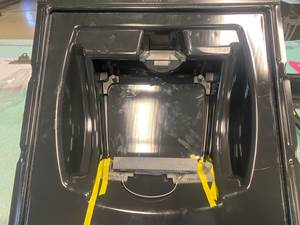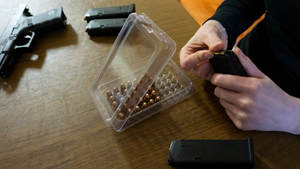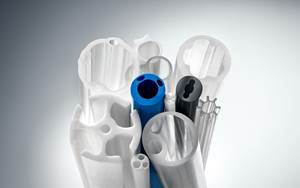Cobot Helps Molder Keep Pace
Collaborative robot boosts process efficiency by 25%, while unburdening workers from the shop floor’s more tedious tasks.
When the employees at Wisconsin Plastics Inc. (WPI), first met their new coworker, a UR5 collaborative robot, or cobot, from Universal Robots, Ann Arbor, Mich., they saw a threat to their jobs. Today, they see an opportunity to work more efficiently.
“Initially everyone was concerned about the robots replacing them,” explains Carl Bartle, plant manager. “Once they realized the robot was there to help their own efficiency, there was a lot of excitement.”
Based in Green Bay, WPI is a contract manufacturer with an emphasis on injection molding and assembly, including its own line of paper-towel dispensers. Game to see how a collaborative robot might fit into its business, the company targeted an existing product—one of its most complicated, in fact—as a test case for integration of a cobot.
“We picked one of our more complicated assembly lines for the cobot,” Bartle says, “one that actually had the most intense human interaction and the most variable rate to it. We figured that if we could do that, we could do anything, so we went all out on the first one.”
KEEPING PACE
A key concept for WPI throughout the process was pace. Not necessarily getting employers to work faster, but creating a process that maintained a steady, repeatable rate of production. The towel-dispenser line, where the cobot was to be tested, formerly saw parts injection molded in one building, packaged, and moved across the street to the assembly facility. Bartle admitted this was inefficient on various levels, but also noted that it was less complicated than trying to put a large assembly line adjacent to a molding machine. Notably, it protected against an inherent risk with that kind of inline assembly scenario: “If you run short on assembly people one day, you might not be able to run the entire line,” Bartle says. “Whereas, if I have the injection molding machine separate, I can at least run the parts. I’m not shutting things down because I’m a person short on assembly.”
One of the advantages claimed for cobots is that they don’t need “hard” guarding to protect human workers in the vicinity. However, in this case, the cobot is largely isolated from likely human interaction.
In the cobot-centered setup, WPI integrated the two injection machines that make the body and the cover of the dispenser. Situated next to each other, they mold parts that are conveyed to a central assembly station. The UR5 cobot removes parts from the machine and places them on a pad-printing fixture, where a customer logo is added. The robot then switches the housings to a second pad-print fixture, where a second customer logo is imprinted. The cobot then pivots and sets the parts on a conveyor for final assembly (see a video of the cell in action at short.ptonline.com/WPI or below).
“By having the robot in between, it allowed us to really reduce the size of the assembly line,” Bartle says, “because the cobot can do multiple tasks in less space than would be required with a human assembly line.”
WPI brought in a new pad printer for the cell and had some special integration fixtures built to help the robot. The machines are running two-cavity molds, so when parts are removed, they’re placed on a fixture that rotates so that the robot can grab from a single orientation instead of multiple orientations. After it places the first part on the fixture, the robot swings back and grabs the second part.
The human footprint in the cell is now significantly smaller, Bartle notes, because assembly tables are no longer needed, since workers combine components directly off a conveyor. “The pad printing and the cobot—that integration all happens in a very small space—and then the cobot hands off to the assembly line,” Bartle explains. “So I don’t really have a square-footage reduction, but you go from an extremely linear line down to a very small, short line that doesn’t extend out much past the footprint of the machine itself.”
WPI has seen an increase in throughput because, as Bartle explains, “When you have the robot driving the cadence, people can maintain that pace more consistently.” Machines know only one speed, or at least they can be set to run at a specific, consistent speed. “Human pace goes up and down throughout the day,” Bartle says. “What this does is allow us to work at the pace of the machine, constantly. The cobot can maintain that pace, and then the humans will naturally maintain that pace too. The cobot didn’t speed anything up, it just works consistently at the same pace. There are fewer distractions for the robot.”
MORE COBOTS COMING
After overcoming initial anxiety about the cobot, WPI’s workers more than embraced the technology, seeking added work for it, not less. “The team we put together to test this out was really active in trying to figure out ways to utilize the robot even more than we originally planned,” Bartle says. “It was the assemblers on the line who were coming up with ideas: ‘What if we position the robot in this direction and have it grab from here?’ And, ‘What if it sets it on the conveyor here vs. there?’ They were really interactive in the process, and they’re really proud of what they’re a part of.”
The integration has been successful enough that WPI is now planning to bring in four more UR cobots over the next few years, according to Bartle. Despite the overall success, he does see one aspect of cobot integration that WPI would change next time around: “I would definitely get the manufacturing team, the assembly crew, the shift supervisor, and our shop technicians involved sooner in the setup because a lot of their ideas were what really took it to the next level.”
The robot can do multiple tasks in less space than would be required with a human assembly line.
Going forward, WPI is considering using cobots to move parts from one location to another, as well as in packaging finished assemblies. “Maybe we can streamline one of those jobs that tend to be a low-skill boring job where folks are easily distracted,” Bartle says, “so I can take my skilled-labor set and apply them to more challenging jobs.”
Increasingly, that’s how WPI sees the role of automation going forward—getting more out of the people they have vs. getting to fewer people. “This is an opportunity for us to change how we’re using our workforce,” Bartle says, “because it can take the boring and tedious tasks away from assemblers and give them more challenging tasks, and at the same time open up some opportunities for robot programmers. The cobot freed up individuals to put them on other lines, which helps us grow, because in this day and age it seems like we tend to be short on employees rather than over.”
Questions About Automation? Visit the Robots Zone.
Related Content
Thermoformer Maximizes Productivity with 3D Printing
Productive Plastics has created an extensive collection of 3D printed manufacturing aids that sharply reduce lead times.
Read MoreMolder Opts for Machine Flexibility for Complex Jobs
AE Plast opted for tiebarless multimaterial Engel victory machines as it took on complex parts for the appliance and power tool market, including a 3K housing for Dremel’s rotary tool.
Read MoreNovel ‘Clamtainer’ Extends Thermoformer's Reach in Packaging
Uniquely secure latching expands applications for Jamestown Plastics’ patented clamshell package design.
Read MoreMedical Manufacturer Innovates with Additive Manufacturing and Extrusion Technology Hubs
Spectrum Plastics Group offers customers two technology hubs — one for extrusion, the other for additive manufacturing — to help bring ground-breaking products to market faster.
Read MoreRead Next
People 4.0 – How to Get Buy-In from Your Staff for Industry 4.0 Systems
Implementing a production monitoring system as the foundation of a ‘smart factory’ is about integrating people with new technology as much as it is about integrating machines and computers. Here are tips from a company that has gone through the process.
Read MoreLead the Conversation, Change the Conversation
Coverage of single-use plastics can be both misleading and demoralizing. Here are 10 tips for changing the perception of the plastics industry at your company and in your community.
Read More













